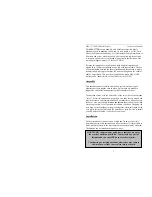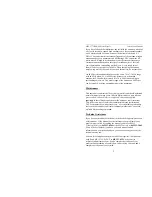
MFJ-1775B 80/40 Meter Dipole Instruction Manual
2
Horizontal Antenna
: Requires two tall supports separated by more than
85 feet. Suspend the antenna with at least a 50 pound working load
nylon rope or equivalent strength weather resistant non-metallic rope.
Never use wire or wire core rope to support the ends of any antenna.
Attach the rope to the end insulators through the empty holes.
Try to keep the antenna as horizontal (level) as possible. The antenna
should be at least 35 feet above ground to give acceptable performance
on 80 Meters, and as high as possible for the best overall performance.
The coaxial cable should drop vertically from the horizontal section of
the antenna as far as is practical.
If you are using trees for end supports, be sure to allow enough slack or
use some type of pulley and counterweight system to prevent the antenna
or rope from breaking when the trees sway in the wind. It is also
possible to use masts, towers, or other tall structures for supports. Try to
keep the ends of the antenna at least five feet from metallic supports.
Inverted "V" Antenna:
Requires only one tall support and places the
least strain on the antenna. Hang the center insulator of the antenna from
the support using a nylon rope or other non-conductive rope tied to the
center hole of the center insulator. The center insulator will be the
highest point of the antenna. If possible, position the two ends of the
antenna so the inside angle they form is at least 120 degrees and not less
than 90 degrees. Secure the antenna ends with nylon or weather resistant
non-metallic rope to suitable supports.
Sloper Antenna:
This antenna also can be suspended as a sloping dipole.
This requires one tall support and one short support. The center of the
antenna must be at least 40 feet above the ground in this configuration. A
sloping dipole radiates mainly in the direction of the downward slope.
The optimum angle of "slope" will varying with the desired coverage and
the frequency of operation, but will almost always be somewhere
between 45 degrees and almost vertical.
Tuning
This antenna comes with the inner sections of wire (between the
feedpoint and the coils) cut to resonate near the center of the 40-meter
band. For operation at only one end of 40 Meters, the 40-meter wires can
be lengthened or shortened to lower or raise the resonant frequency. Do
this
before
adjusting the lengths of the 80 meter wires (the wires from the
coils to the ends of the antenna) – and after you temporarily install the
antenna and determine its resonant point on 40 Meters.



















![Panorama Antennas L[G]M[X] Series Installation Instructions preview](http://thumbs.mh-extra.com/thumbs/panorama-antennas/l-g-m-x-series/l-g-m-x-series_installation-instructions_3471305-1.webp)

